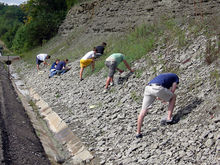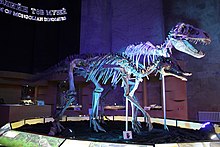Fossil collecting
This article needs additional citations for verification. (September 2010) |

| Part of a series on |
| Paleontology |
|---|
 |
|
Paleontology Portal Category |
Fossil collecting (sometimes, in a non-scientific sense, fossil hunting) is the
Process
Locating fossils
Rock type
Fossils are generally found in
Preservation
After burial various factors are at work to endanger the current fossil's preserved state. Chemical alteration would change the mineral composition of the fossil, but generally not its appearance, lithification would distort its appearance, the fossil itself may be fully or partially dissolved leaving only a fossil mold.[2][4]
Exposure

Areas where sedimentary rocks are being eroded include exposed
Wave-washed sea cliffs and foreshore exposures are often good places to search for fossils,
Generally in appearance, a fossil will be either a different colour to the surrounding rock, because of the different mineral content, will have a defining shape and texture or a combination of both. A fossil can also be extracted from its geological environment, having similar characteristics in colour naturally embed from the sedimentary formation (surrounding rock) it was found within.[4]
Collecting techniques
The techniques used to collect fossils vary depending on the sediment or rock in which the fossils are to be found. For collecting in rock a
Fossils tend to be very fragile and are generally not extracted entirely from the surrounding rock (the matrix) in the field. Cloth, cotton, small boxes and aluminum foil are frequently used to protect fossils being transported. Occasionally, large fragile specimens may need to be protected and supported using a jacket of
Preparation and cleaning
Sometimes, for smaller fossils, a stiff brush may simply be used to dust off and clean the fossil. For larger fossils, a chisel can be used to remove large bits of dirt, however, you run the risk of damaging the fossil. Running water can cause some types of fossils to either dislodge from the rock, or even crumble and break apart, for they are very fragile. Dental tools are sometimes used to remove small amounts of rock from the fossil.
Documentation
A knowledge of the precise location a fossil is essential if the fossil is to have any scientific value. Details of the parent rock strata, the location of the find, and other fossil material associated with the find help scientists to place the fossil in context, in terms of the time, location and situation in which the organism lived.
Collecting ethics
To collect fossils, there are various legal realities that must be observed. Permission should be sought before collection begins on private land.
The first expressly worded fossil-collecting code was published from the museum-home of pioneering geologist
The code advises fossil collectors to seek permission from landowners, to collect responsibly, record details, seek advice on finding an unusual fossil and label the specimens and care for them. Its principles establish a framework of advice on best practices in the collection, identification, conservation and storage of fossil specimens.
The non-binding
Fossil trade

Fossil trading is the practice of buying and selling fossils. This is illegal when it comes to stolen fossils, and some important scientific specimens are sold to collectors, rather than given or obtained by museums and institutes of study.[12][13][14][15] Much focus has been put on the illegal fossil dealing in China, where many specimens have been stolen.[16] The fossil trade of Morocco has also been the focus of international attention. The trade is lucrative, and many celebrities collect fossils.[17]
The
Many commercial fossil collectors and dealers believe that such policies are a breach of their rights. The argument has also been put forth that there are too few professional paleontologists to collect and preserve fossils currently exposed to the elements, and that it is therefore essential that private citizens be allowed to collect them for the sake of their preservation. Eric Scott, the Curator of Paleontology for the San Bernardino County Museum, argues that 1) private citizens and amateur (not for profit) collectors can and do participate frequently in the permitted recovery and preservation of significant vertebrate fossils, and 2) preservation of significant fossils does not require or mandate sale of those fossils.[19]
According to the ethics by-law of SVP, "The barter, sale, or purchase of scientifically significant vertebrate fossils is not condoned, unless it brings them into or keeps them within a public trust."[20]
Some fossil trade is not for collecting but due to the use of certain fossils in traditional medicine mainly in East Asia but also in Europe and other places.[21]
Societies and clubs
Many include fossil collectors. Lapidary clubs also include fossil collectors. In addition, paleontological societies and fossil clubs exist. There is some overlap between fossil collecting, mineral collecting, and amateur geology.

Notable fossil collectors
- Mary Anning
- Robert Bakker
- Edward Drinker Cope
- Phil Currie
- Othniel Charles Marsh
- Paul Sereno
- Charles Hazelius Sternberg
- Peter Larson
- Stan Wood
- Fisk Holbrook Day
- Triebold Paleontology Incorporated
See also
- Fossil park
- Lapidary club
- List of fossil sites
- Mineral collecting
- National Fossil Day
- Paleontologist
- Paleozoology
- Prehistoric life
References
- ^ "Where to look for fossils". San Diego Natural History Museum. Archived from the original on 2007-09-07. Retrieved 2007-09-06.
- ^ ISBN 0-540-08374-7.
- ^ "Stratigraphy Fossil-Bearing Rocks". The Rochester Academy of Science. Archived from the original on 2004-09-18. Retrieved 2007-09-11.
- ^ a b "How to look for fossils". San Diego Natural History Museum. Archived from the original on 1999-02-19. Retrieved 2007-09-06.
- ^ "Best Places in the US to Find Dinosaur Fossils". Archived from the original on 2022-01-12. Retrieved 2022-01-12.
- ^ "Dinnertime at Cuddie Springs: hunting and butchering megafauna?". Judith Furby, School of Archaeology, The University of Sydney, NSW 2006. Archived from the original on 2007-11-14. Retrieved 2007-09-11.
- ^ "Development of the Naracoorte Caves". South Australian Parks Web. Archived from the original on 2007-09-01. Retrieved 2007-09-11.
- ^ "Discover what you have". San Diego Natural History Museum. Archived from the original on 1999-10-05. Retrieved 2007-09-06.
- ^ "Do's and don'ts for fossil hunters". American Museum of Natural History. Archived from the original on 2007-08-10. Retrieved 2007-09-06.
- ^ "English nature's code of collecting". Archived from the original on January 14, 2002.
- ^ "Geology.com: an early draft of the full code". Archived from the original on June 24, 2007.
- ^ Milmo, Cahal (2009-11-25). "Fossil theft: One of our dinosaurs is missing". The Independent. London. Archived from the original on 2017-06-23. Retrieved 2010-05-02.
- ^ Simons, Lewis. "Fossil Wars". National Geographic. The National Geographic Society. Archived from the original on 2012-02-27. Retrieved 2013-05-31.
- ^ Willis, Paul; Clark, Tim; Dennis, Carina (18 April 2002). "Fossil Trade". Catalyst. Archived from the original on 24 May 2012. Retrieved 31 May 2013.
- ^ Farrar, Steve (5 November 1999). "Cretaceous crimes that fuel the fossil trade". Times Higher Education. Archived from the original on 20 August 2012. Retrieved 2 November 2011.
- ISSN 0272-4634.
- ^ Luxury Market For Dinosaur Remains Thrives, The Huffington Post, 10 November 2010, archived from the original on 12 February 2017, retrieved 21 May 2012
- ^ "Statement regarding the sale of vertebrate fossils online". Archived from the original on July 14, 2010.
- .
- ^ "Statement regarding the sale of vertebrate fossils online". The Society of Vertebrate Paleontology. Archived from the original on 3 April 2012. Retrieved 2 November 2011.
- ^ van der Geer, Alexandra; Dermitzakis, Michael (2010). "Fossils in pharmacy: from "snake eggs" to "Saint's bones"; an overview" (PDF). Hellenic Journal of Geosciences. 45: 323–332. Archived (PDF) from the original on 2013-06-19. Retrieved 2018-12-15.
Further reading
- ISBN 0-691-08977-9
- Adrienne Mayor, Fossil Legends of the First Americans (Princeton University Press 2005) — ISBN 0-691-11345-9
